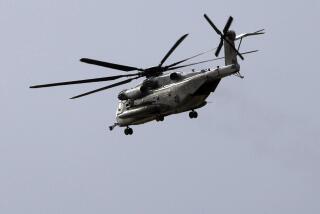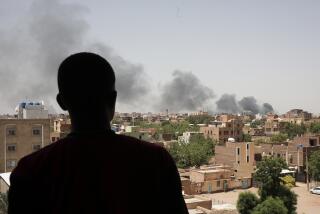Marines Occupy Bardera, Arrive in Hoddur
- Share via
MOGADISHU, Somalia — The U.S. Marines on Thursday occupied the interior city of Bardera, the site of some of this country’s worst famine, as the American troop expansion into the Somali countryside continued.
The 800 Marines first secured the town’s airport, then moved into Bardera itself after an all-day drive from Baidoa, which was taken last week in the American military’s first major action after landing in Mogadishu on Dec. 9.
Col. Fred Peck, U.S. Marine military spokesman, said there was no opposition nor any incidents.
Another troop convoy--made up of 400 French Legionnaires and U.S. Marines--also left Baidoa Thursday for the town of Hoddur, another center of starvation and disease. That force, slowed by bad roads, stopped 18 miles from town at nightfall but entered Hoddur shortly after sunrise today.
The object of both missions, as well as the occupation of other cities, is to make it possible to distribute food and medical supplies to the hundreds of thousands of Somalis starved by war and famine. Previous civilian relief efforts have failed because of the civil war, looting and general lawlessness. As a result, at least 300,000 Somalis have died here since 1989.
The first task in Bardera, now that it is deemed secure, is to set up a feeding center for 25,000 people there. Troops then will begin fanning out into the area to establish regional aid stations, starting today, Peck said. “We want to start branching out on food delivery,” he said, “to avoid becoming a magnet for even more refugees.”
Bardera already has 15,000 refugees; Hoddur has 10,000 displaced people, besides its normal population of 10,000.
The work promises to be slow, Peck added, because of the need to clear mine fields, repair the airport so it can receive large planes and rebuild the cities’ infrastructure. Bardera, for example, has no potable water because looters recently stole pumps that ran the city’s water purification plant.
On Thursday, three Americans wounded by a land mine on Wednesday were flown back to the United States. The men, State Department security officers, were in stable condition. They were part of an advance team that was working near Bardera when their jeep hit the mine; a colleague, a civilian U.S. Army employee, was killed.
Peck said Thursday that experts have identified the deadly device as an old Soviet antitank mine; it had been planted in the area some time ago. “There is no way of telling who planted it,” he said, pointing out that all factions in the Somali civil war had used mines.
But, he said, there was no evidence that American forces were the target of the mine.
In the United States, Marine Gen. Joseph P. Hoar, commander in chief of U.S. Central Command, said much of the region surrounding Bardera is seeded with land mines left in place since the end of Somalia’s fighting with Ethiopia and its clan-based civil war.
“There are clear tracks (of land mines) from Baidoa down to Bardera,” Hoar said, adding that the greatest concentration of mines is around Bardera and on the roads leading out of it.
“We have known for some time there were mines in that area,” Hoar told a television interviewer. “Clearly our ability to go over the road from Baidoa to Bardera involves the capability of clearing mines on that road.”
Marine combat engineers employ a number of different methods to clear mines. The most common techniques involve sending bands of Marines carrying magnetic metal detectors, or to use a mine-clearing vehicle first designed and used in World War II. The latter is essentially a “mine plow” attached to a tank or an armored personnel carrier, which pushes mines off to the side of a designated corridor until they can be detonated and destroyed later.
In combat assaults, Marines often use “line charges”--long strings of wire dotted with high-explosive. When the explosives are triggered, they create pressure that in turn detonates the mines.
Gunnery Sgt. Dennis Cheshier, a combat engineer based at Camp Pendleton, said that such assault techniques will likely not be used in Somalia, where there is time to do a more thorough job. Cheshier added that the Somali mines appear to be scattered in patterns well-known to American troops, since Somali soldiers appear to have been trained in the technique by the Soviets. While that has lessened the dangers to Marines, Cheshier warned that they still exist.
“Anytime you deal with any type of ordnance it’s dangerous, but it’s not anything we haven’t been trained to do.”
With the occupation of Bardera and Hoddur, only two more towns remain unsecured, Belet Huen and Gailalassi, both relatively small places where no resistance is expected. Those cities will be taken Sunday and Monday, thus completing the first three phases of the original four-phase operation outlined when the United Nations put together the American-led military coalition to deal with Somalia.
The next phase, the quick withdrawal of American combat forces in favor of a U.N. peacekeeping force, continues to be a far greater problem that any opposition faced so far by the troops. Peck said again Thursday that the American goal continues to be a quick pull-out of U.S. troops.
U.N. officials here, echoing the views of Secretary General Boutros Boutros-Ghali, say the American combat forces must stay at least for six months, if not longer. As one official explained: “Things may look peaceful now, but everyone still has guns, the civil war isn’t over and there is no political settlement in sight. We can feed the people now, but once the troops are gone, it could all go to hell again.”
The American position is that U.S. combat forces should be replaced by 30,000 U.N. peacekeepers with American support.
The security situation remained unstable in Mogadishu on Thursday. American forces occupy only the southern part of the city; the northern section still is a dangerous, lawless place.
Peck said Marine patrols would soon move into northern Mogadishu but not until more troops arrive. He said most of the 12,000 combat troops here are tied up with such operations as taking Bardera and maintaining security.
Times staff writer Melissa Healy in Washington contributed to this report.
More to Read
Sign up for Essential California
The most important California stories and recommendations in your inbox every morning.
You may occasionally receive promotional content from the Los Angeles Times.










